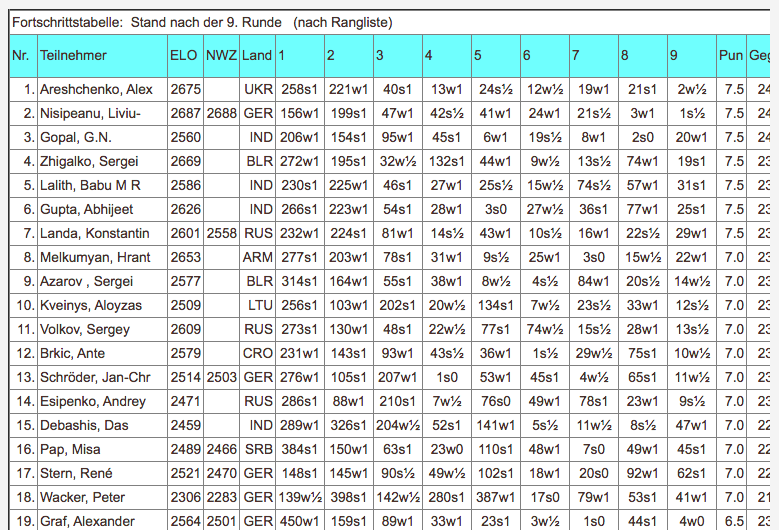Bad tiebreaks
The recent strong chess open in the German town of Bad Wiessee was won by my Werder Bremen teammate, the Ukrainian GM Alexander Areshchenko. Areshchenko is perhaps best known as being currently the world’s best expert on playing the Najdorf, though perhaps Maxime might have something to say about that.
Areshchenko finished in a massive seven-player tie for first on 7.5 out of 9, but edged the field on tie-break. And I really mean ‘edged’, because the average rating of his opponents was less than two points higher (2428.9 versus 2427) than that of his nearest rival, Liviu-Dieter “Peanut Man” Nisipeanu.

I’ve written before about the occasional insanity of tie-break systems (see here, and here). But from this and my subsequent research, two things are certain. First, there’s no clearly best tie-break system in chess. And second, some systems are clearly worse than others.
All methods have basically the same goal: To work out which player performed better, given the same score. (For completeness, the “most-wins” tie-breaks have other goals, namely, incentivising fighting chess.) For example, the point of the average-rating tie-break used in Bad Wiessee was to see which player managed to score their 7.5 points against the strongest opposition. Now in principle, this makes some sense. But given that the tournament didn’t really ‘start’ for the top players until round 4 (13 of the top 14 finishers started with 3/3), it seems a little illogical to me that the precise ratings of the early-round cannon fodder should count for a third of the tie-break score. This is my main argument for why average-rating shouldn’t be used in big Opens, or in fact any event where players can expect a large variance in the ratings of their opponents (for most of the place-getters, the range was around 700 ELO).
But what I really don’t understand is why the individual match between Areshchenko and Nisipeanu was included. The point of a tie-break is to separate players who are otherwise considered equal in ranking. Including matches between said players by definition assumes that the players are not equal. It’s circular reasoning that makes no sense mathematically or logically. In words, the tie-break essentially claims that “Player A and B finished at equal rank, but Player A performed stronger than Player B because we assume that Player B is stronger than Player A.”
Fortunately, in this case the result would be the same: Areshchenko’s average rating without the final round game would be 2396.6, just a fraction ahead of Nisipeanu’s score of 2396.0. So the right result was proclaimed (according to this tie-break system, anyway). On the other hand, if we imagine that the two player’s ratings were reversed, then exactly the wrong result would have eventuated, for the same reasons (although then the pairings would have been affected).
Anyway, I guess the math mistake was not a big deal here, and in general in these Open tournaments the probability of there being a big impact isn’t very high. But there are plenty of worse examples out there in terms of consequences, such as the insanely complicated tie-breaks of the recent chess Olympiad. USA won its first gold medal in 40 years after scoring the same points as Ukraine, but winning on tie-break. The key moment was when another of my Werder Bremen teammates, Matthias Blübaum, profited from a terrible blunder by his Estonian opponent in the match on board 28 (!). If instead he’d drawn, Ukraine would be the champion, hence explaining why Hikaru Nakamura posted this post-victory tweet:
Matthias Bluebaum with the win of the tournament! Thanks for the help, Germany! 🙂
— Hikaru Nakamura (@GMHikaru) September 13, 2016
Oh well. Maybe I should pick up working on the Smerdon system?
The other annoying thing about average rating of opponents is that the players have very little influence on it. For organizers it is nice, because it’s easy to calculate and the chance of being the same for two players is small.
Progressive score is decent (sum of the scores after each round) because it makes the “Swiss Gambit” less attractive, getting a high score quickly usually means you meet the strongest opponents. I don’t know if it was used here or if it would have made a difference.
But at least this is a Swiss and there is a difference in the opponents they faced, so reasonable tiebreaks are at least possible. In Round Robins there are no tiebreaks that make sense.